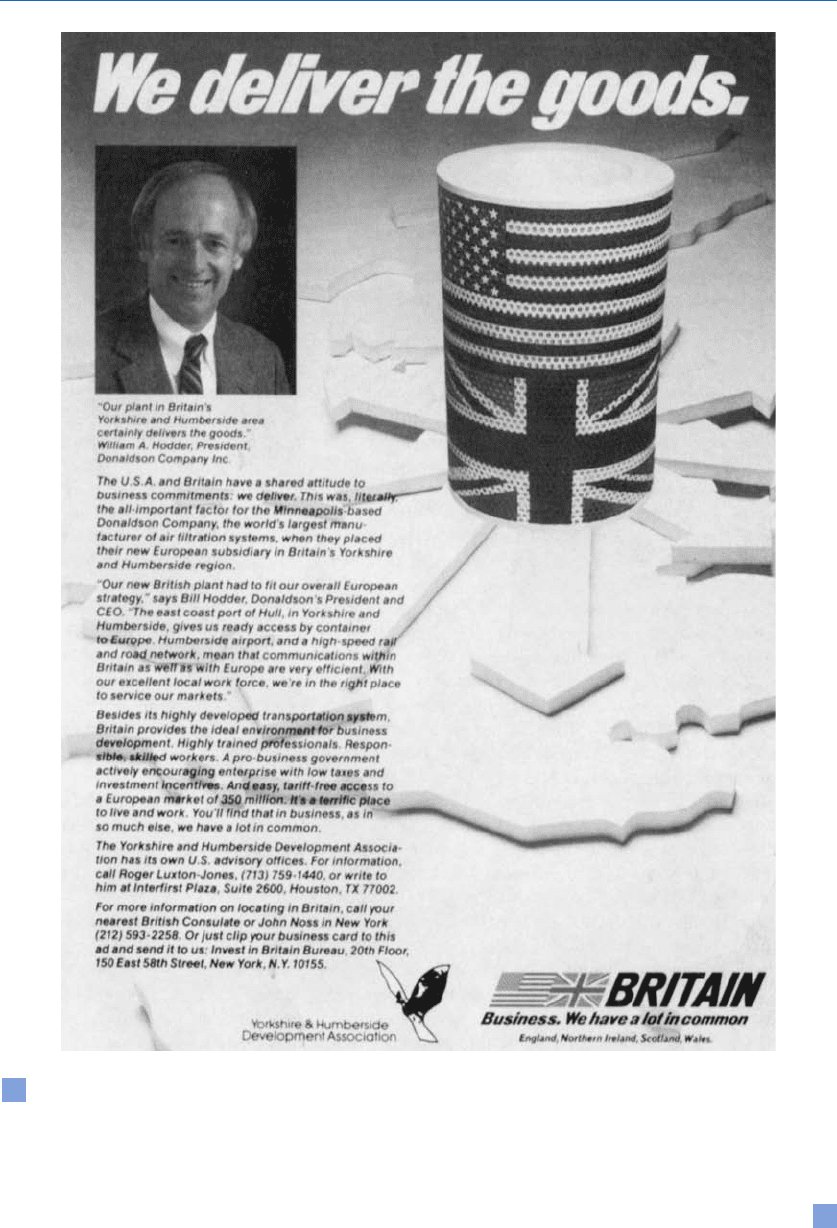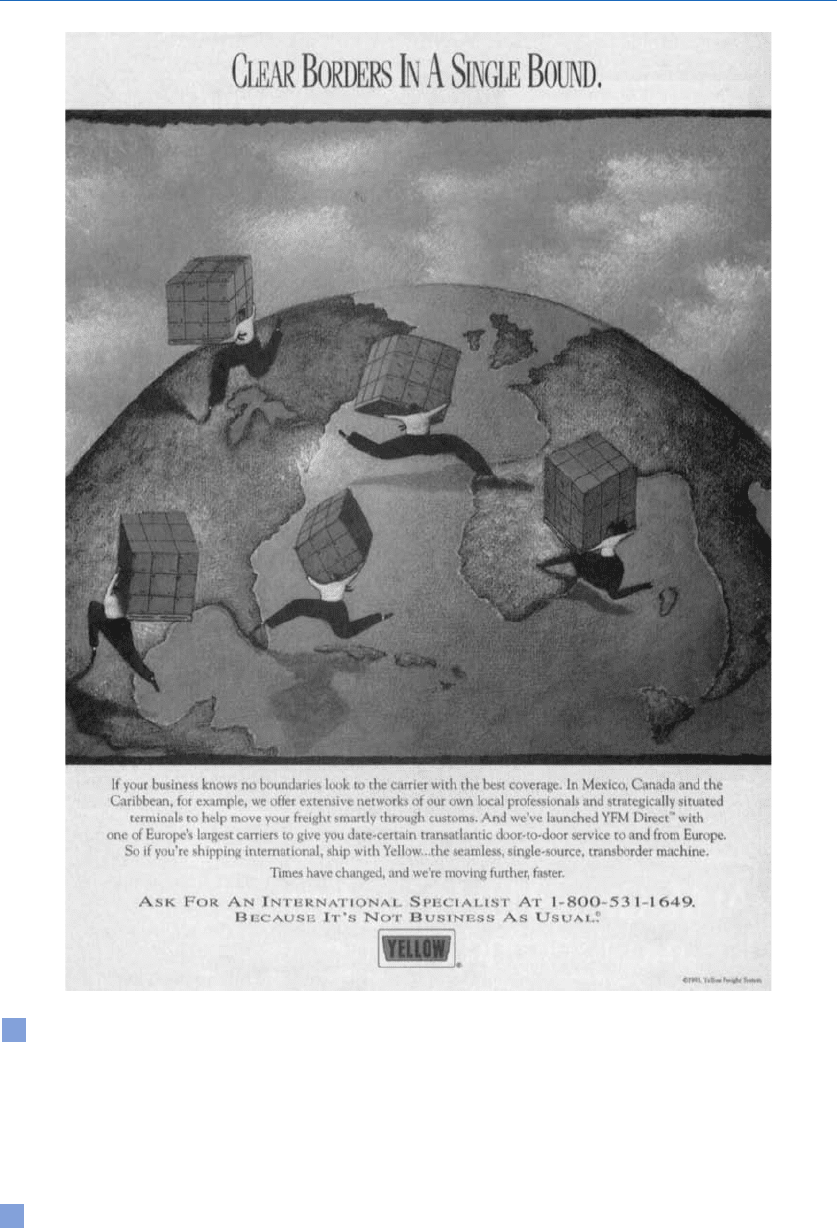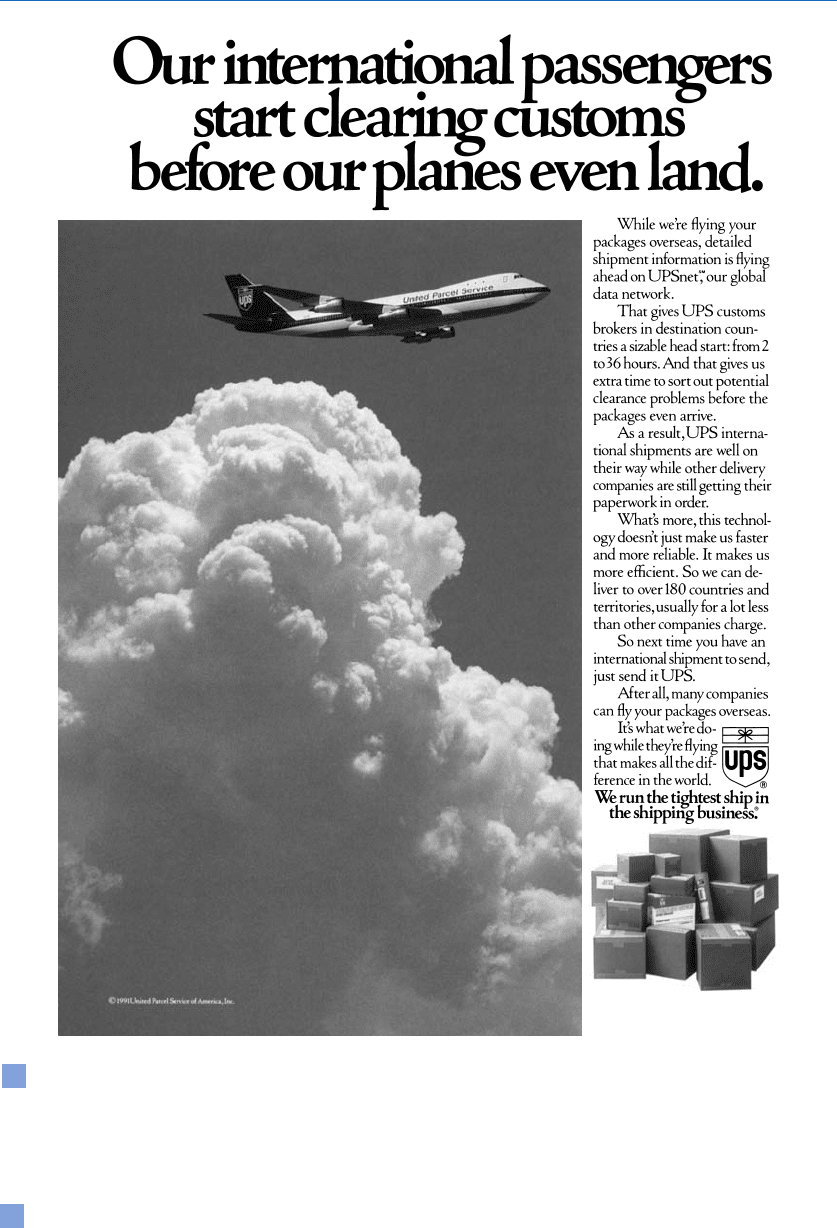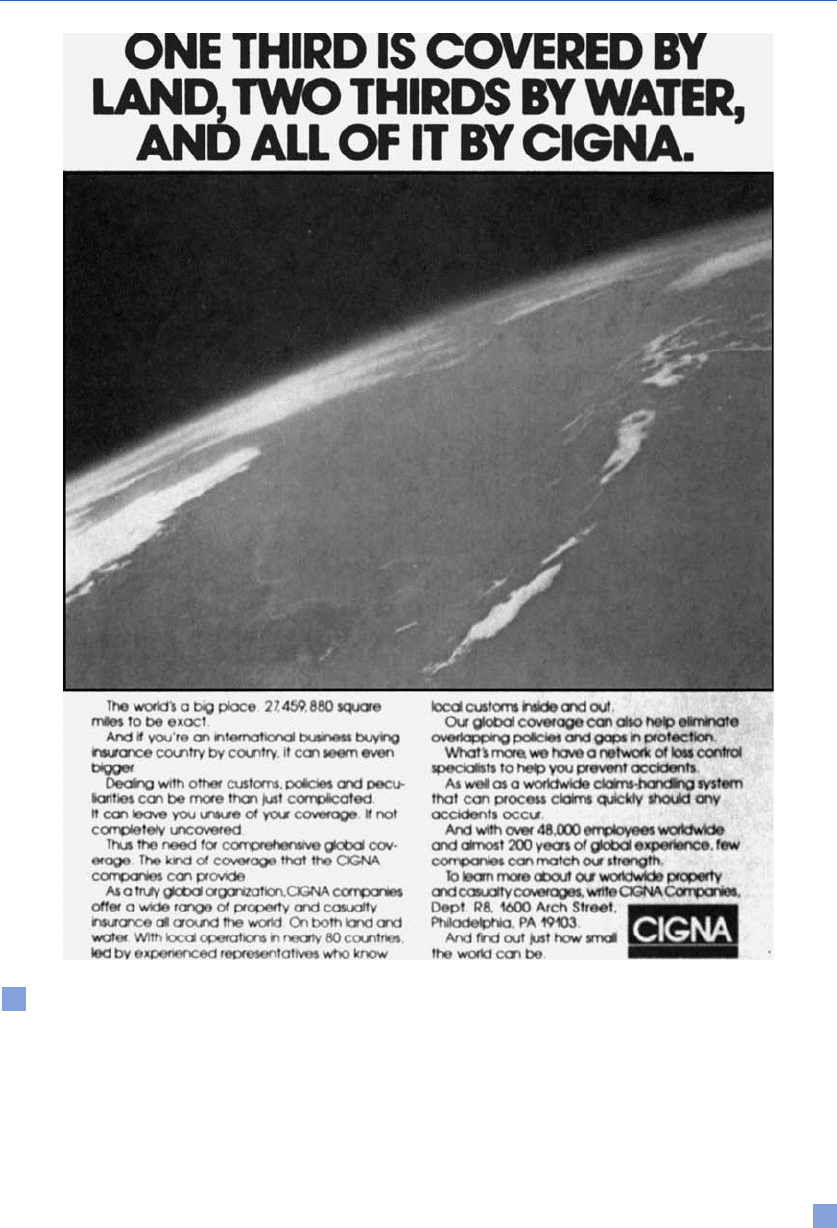Onkvisit S., Shaw J. International Marketing: Analysis and Strategy
Подождите немного. Документ загружается.


386
Imagine a world without lawyers, accountants, and insurance agents.
Murray L. Weidenbaum
CHAPTER OUTLINE
■ Modes of transportation
Land
Air
Water
■ Cargo or transportation insurance
■ Packing
Packing problems
Containers
■ Freight forwarder and customs broker
■ Documentation
Shipping documents
Collection documents
■ Conclusion
Physical distribution and
documentation
Chapter 13

1111
2
3
4
5
6
7
8
9
10111
1
2
3
4
5
6
7
8
9
20111
1
2
3
4
5
6
7
8
9
30
1
2
3
4
5
6
7
8
9
40
41
42
43
44
45111
387
PHYSICAL DISTRIBUTION AND DOCUMENTATION
PURPOSE OF CHAPTER
Distribution is a necessary as well as a costly activity. According to one executive at Procter & Gamble,
the average time required to move a typical product from “farm to shelf” is four to five months. Although
it takes only about seventeen minutes to actually produce a product, the rest of the time is spent in
logistical activities – storage, handling, transportation, packing, and so on.
1
In the developed economies, the distribution sector typically accounts for one-third of the gross domes-
tic product (GDP).
2
Furthermore, international logistics costs can account for 25 to 35 percent of the sales
value of a product, a significant difference from the 8 to 10 percent for domestic shipment.
3
Examples that could demonstrate some of the difficulty in physically moving products overseas are
endless. Firms can become easily frustrated by the physical distribution problems overseas. Port conges-
tion coupled with the lack of efficient materials handling equipment can cause long delays. Even inland
movements can be a problem because some road networks cannot accommodate long containers and rail
gauges vary across countries. China, for example, intentionally uses different rail gauges for security reasons
(i.e., to prevent quick troop movement in the case of a foreign invasion). Not only must a company make
arrangements for transportation, but it must also pay attention to how the product is packed for shipping.
The process requires a great deal of paperwork throughout.
Paperwork is a global problem. It impedes trade, chokes a flow of trade, costs jobs, and loses govern-
ment revenue. To move goods across borders worldwide, nine billion documents are required each year.
According to the United nations Conference on Trade and Development, an average customs transaction
involves twenty-seven parties, forty documents, 200 data elements (thirty of them are repeated at least
thirty times), and the retyping of 70 percent of all data at least once. Of course, in many countries, the
import-export paperwork is worse.
4
This chapter examines the various issues related to the process of moving a product from one country
to another, beginning by comparing and contrasting the major transportation modes. The discussion then
focuses on insurance and packing for export. Next, the chapter examines two kinds of intermediaries that,
in the area of physical distribution, are virtually indispensable – freight forwarders and customhouse
brokers. Finally, a significant portion of the chapter is devoted to a discussion of documentation, including
both shipping and collection documents.
Benetton’s Sisley line of clothing contains microchip
transmitters that make it possible for the Italian
company to track its garments from the point of man-
ufacture to the moment they are sold in any of its
5,000 stores. Philips Semiconductors has introduced
the “smart tag” tracking technology. This technology
employs a Philips Electronics radio frequency ID tag
which replaces the traditional bar codes that have to
be manually scanned.The ID is actually embedded in
the clothes.This antenna-bearing chip is smaller than
a grain of rice and is attached to clothes’ labels. Any
item returned to a store will automatically re-enter
the inventory.
In many or perhaps most cases, marketers may
find that it is much more practical to leave the
physical distribution activities to specialists. Dell
Computer Corp., for example, sells computers in 115
countries. It has arranged for Roadway Services Inc.
to handle Dell’s worldwide shipping. Earlier, Dell had
to deal with dozens of carriers and found that it would
have to hire 1000 to 2000 additional workers to meet
the projected growth. Roadway, as a single-source
provider, subcontracts and manages all customer ship-
ments – both inbound and outbound.
MARKETING ILLUSTRATION THE PAPER CHASE

MODES OF TRANSPORTATION
The availability of transportation is one important
factor affecting a company’s site selection, as noted
in Figure 13.1. To move a product both between
countries and within a country, there are three
fundamental modes of transportation: air, water
(ocean and inland), and land (rail and truck). Ocean
and air shipments are appropriate for transportation
between countries, especially when the distance is
considerable and the boundaries are not joined.
Inland water, rail, and highway are more suitable for
inland and domestic transportation.When countries
are connected by land (e.g., North America), it is
possible to use rail and highway to move merchan-
dise from locations, such as from the USA to
Canada. In Europe, rail is an important mode due
to the contiguity of land areas and the availability of
a modern and efficient rail system.
The appropriate transportation mode depends
on (1) market location, (2) speed, and (3) cost. A
firm must first consider market location. Contiguous
markets may be served by either rail or truck, and
such is the case when goods are shipped from the
USA to Canada or Mexico.To move goods between
continents, ocean or air transportation is needed.
Speed is another consideration. When speed is
essential, air transport is without question the pre-
ferred mode of distribution. Air transport is also
necessary when the need is urgent or when deliv-
ery must be quickly completed as promised. For
perishable items, a direct flight is preferable because
a shorter period in transport reduces both spoilage
and theft.
Finally, cost must be considered as well. Cost is
directly related to speed – a quick delivery costs
more. But there is a tradeoff between the two in
terms of other kinds of savings. Packing costs for air
freight are less than for ocean freight because for
air freight the merchandise does not have to be in
transit for a long period of time, and the hazards are
relatively lower. For similar reasons, the air mode
reduces the inventory in float (i.e., in the movement
process).Thus, there is less investment cost because
the overall inventory is minimized and inventory is
turned over faster.
A firm must understand that there is no ideal
transportation mode. Each mode has its own special
kinds of hazards.
5
Hazards related to the ocean/
water mode include wave impact, navigation expo-
sures, water damage, and the various vessel motions
(rolling, pitching, heaving, surging, swaying, and
yawing). Hazard related to the air mode include
ground handling and changes in atmospheric pres-
sure and temperature. Hazards related to the rail
and highway modes include acceleration/decelera-
tion (braking), coupling impact, swaying on curves,
and shock and vibration. Figure 13.2 describes the
services of Yellow Freight System, an international
carrier.
Land
Land transportation is an integral part of any ship-
ment, whether locally or internationally. Some type
of land transportation is necessary in moving goods
to and from an airport or seaport.The land trans-
portation mode involves rail and truck. When a
large quantity of goods needs to be moved over
a long distance by land, rail can prove to be quite
economical. Europe and Japan have modern rail
systems that are capable of moving merchandise
efficiently.
On the other hand, trucks are capable of going
to more places. In addition, trucks may be needed
to take cargo to and from a railway station. When
countries have joint boundaries, moving cargo by
truck or train is often a practical solution. As a
matter of fact,the US trucking industry is quite con-
cerned about a NAFTA agreement which allows
Mexican drivers to drive their trucks into the USA.
It is debatable whether the real issue is a safety
concern or a trade barrier.
Less developed countries generally rely on road
transport. In Sub-Saharan Africa, road transport is
the dominant form of transport.
6
This form of trans-
port accounts for 80 to 90 percent of the region’s
passenger and freight movements. Unfortunately,
the nearly two million kilometers of roads in Africa
have been greatly damaged due to years of neglect.
In any case, road transport may be the only access
388
PHYSICAL DISTRIBUTION AND DOCUMENTATION

1111
2
3
4
5
6
7
8
9
10111
1
2
3
4
5
6
7
8
9
20111
1
2
3
4
5
6
7
8
9
30
1
2
3
4
5
6
7
8
9
40
41
42
43
44
45111
389
PHYSICAL DISTRIBUTION AND DOCUMENTATION
Figure 13.1 Transportation and site selection
Source:
Reprinted with permission of Yorkshire and Humberside Development Association.

390
PHYSICAL DISTRIBUTION AND DOCUMENTATION
Figure 13.2 International carrier

to most rural communities – a situation common in
Africa as well as in other developing economies.
Air
Of all the various transportation modes, air
accounts for only about 1 percent of total inter-
national freight movement; yet it is the fastest-
growing mode and is becoming less confined to
expensive products. Air transport has the highest
absolute rate, but exporters have discovered that
there are many advantages associated with this
mode. First, air transport speeds up delivery, mini-
mizes the time the goods are in transit, and achieves
greater flexibility in delivery schedules. Second, it
delivers perishables in prime condition. Harris
Ranch uses a 747 jumbo jet to fly live cattle from
the USA to Japan.A premium price commanded by
high-quality beef in Japan makes it possible to use
air freight.
Third,it can respond rapidly to unpredictable and
urgent demand. For instance, quick replacement of
broken machinery, equipment, or a component part
may be made by air.Fourth, it reduces to a minimum
damage, packing, and insurance costs. Finally, it can
help control costly inventory and other hidden costs,
including warehousing, time in transit, inventory
carrying cost, inventory losses, and the paperwork
necessary to file claims for lost or damaged goods.
These costs will increase as the time in transit
increases.Furthermore,opportunity costs (e.g., lost
sales and customer dissatisfaction) also adversely
affect profit, especially in the long term.All of these
costs can be minimized with air transport.
Traditionally, the appropriateness of air freight
was determined solely by a value-to-weight equa-
tion, which dictated that air cargo should be con-
fined to high-value products. One reason for that
determination was that transport cost is a small pro-
portion of such products’ value.Another reason was
that the amount of capital tied up with these prod-
ucts while in transit is high and should be released
as soon as possible.
Recently, shippers have begun to shift their
attention to the freight rates–density effect, which
determines true costs rather than absolute costs of
each transportation mode.
7
Air freight rates are
usually quoted per unit of weight, and sea freight
rates are usually quoted per unit of weight and
volume (whichever yields more revenue for the
steamship). For example, assume the freight rates
are $350/ton by air and $60/ton and/or cubic ft by
sea.At first, it would appear that surface (sea) trans-
portation is a great deal cheaper, but for a product
that is 1 ton and 7 cubic ft, the cost of sea freight
($420) is actually higher than that of air freight
($350). Therefore, sea freight is very cheap when
goods are very dense (i.e., low volume per unit of
weight). However, as density declines (i.e., the
increase in bulk in relation to constant weight), the
charge for sea freight rises rapidly. Consequently, air
freight is quite competitive for such low-density
goods as ladies’ shoes, men’s shoes, computers,
color TV sets, refrigerators, and towels.
The dominant form of the international trans-
portation of merchandise has always been ocean
transport. Its main advantage is its low rate, though
the savings achieved for many products are not nec-
essarily greater than other transport modes on an
overall basis. This helps explain why, when all the
hidden costs related to ocean transportation are
considered, air transportation is growing at a very
rapid rate (see Figure 13.3).
Half a century ago, virtually all overseas trade
went by ship. The use of air freight for high-value,
time-sensitive products has jumped since then.The
air mode has made it possible to outsource high-
technology products (e.g., computers).A reduction
in transit time by one day can reduce a product’s
price by 0.8 percent. Based on over $800 billion of
manufactured imports per year, an extra day can add
$7 billion to the costs. Because an ocean shipment,
on average, takes twenty days, a shift from a twenty-
day ocean shipment to a one-day air shipment can
lower the price of a product by about 15 percent.
8
Water
Bulk shipping is important in international trade
because it is one of the most practical and efficient
1111
2
3
4
5
6
7
8
9
10111
1
2
3
4
5
6
7
8
9
20111
1
2
3
4
5
6
7
8
9
30
1
2
3
4
5
6
7
8
9
40
41
42
43
44
45111
391
PHYSICAL DISTRIBUTION AND DOCUMENTATION

392
PHYSICAL DISTRIBUTION AND DOCUMENTATION
Figure 13.3 Air freight and customs

means of transporting petroleum, industrial raw
materials, and agricultural commodities over long
distances.About 51 percent of the global bulk fleet
consist of oil tankers, while dry bulk carriers
account for 43 percent.The remainder of the fleet
is made up of combination carriers which are
capable of carrying either wet (crude oil and refined
petroleum products) or dry (coal, iron ore, and
gain) bulk cargoes.The bulk shipping industry, being
highly fragmented, has no one organization which
holds more than 2 percent of the total world fleet.
9
Quotations for ocean shipping may be obtained
from a shipping company or a freight forwarder.
Steamship rates are commonly quoted on weight
and measurement. Goods are both weighed and
measured, and the ship will use the method that
yields a higher freight charge. Less-than-container
shipments carry a higher rate than full-container
shipments.
There are three basic types of shipping company:
(1) conference lines, (2) independent lines, and (3)
tramp vessels. An ocean freight conference line
is an association of ocean carriers that have joined
together to establish common rules with regard to
freight rates and shipping conditions. Consequently,
the operators in the group charge identical rates.
The steamship conference has also adopted a dual
rate system, giving a preferential treatment to con-
tract exporters. A contract exporter agrees to ship
all or a large portion of its cargo on a regular basis
on vessels of conference member lines – in
exchange for a lower rate than that charged for a
noncontract shipper. Nevertheless, the contract
exporter is allowed to use another vessel, after
obtaining the conference’s permission, when no
conference service is available within a reasonable
period of time.
An independent line, as the name implies, is
a line that operates and quotes freight rates individ-
ually and independently without the use of a dual-
rate contract. Independent lines accept bookings
from all shippers.When they compete with confer-
ence lines for noncontract shippers, they may lower
their rates. In general, independent lines do not
offer any special advantage for a contract shipper
because they do not have a significant price advan-
tage. Furthermore, their services are more limited
and not as readily available.
Finally, a tramp vessel is a ship not operating
on a regular route or schedule; that is, tramp steam-
ers do not have the established schedules of the
other two types of carriers. Tramp vessels operate
on a charter basis whenever and wherever they can
get cargo. They operate mainly in carrying bulk
cargoes.
In some circumstances, a shipper may not have
an option on the vessel to be used. Due to certain
laws enacted to protect a country’s interests,
mandatory use of a particular vessel is not uncom-
mon. Brazil’s shipping restrictions require goods
imported for use by public or public-supported
enterprises to be transported aboard vessels with a
Brazilian flag. All exported Japanese automobiles
must be shipped on Japanese-owned ships, and the
same restriction applies to all tobacco leaf imported
to Japan.
The USA, while accusing other nations of erect-
ing trade barriers, has the Federal Cargo Preference
Act, which supports and favors US shipowners
and maritime workers over foreign-flag vessels.
Shipping between American coastal ports, including
the movement of Alaskan oil, is legally reserved pri-
marily for US flag vessels owned by American citi-
zens, crewed by US seafarers, and built in the
USA without construction subsidies and operated
without using differential subsidies. Such vessels
also receive preference in carrying US military and
US government-sponsored shipments throughout
the world.
In general, the rates charged by US conference
lines are higher than the rates charged by lines of
other nations. Foreign operators are able to charge
lower rates because of the subsidies and support
received from their governments. Soviet ships
at one time were able to quote rates as much as
two-thirds lower than US conference lines’ pub-
lished prices. Subsequently, conference lines (e.g.,
Seatrain) decided to give illegal rebates to major
customers in order to win back cargo shipments lost
to the Soviets.
1111
2
3
4
5
6
7
8
9
10111
1
2
3
4
5
6
7
8
9
20111
1
2
3
4
5
6
7
8
9
30
1
2
3
4
5
6
7
8
9
40
41
42
43
44
45111
393
PHYSICAL DISTRIBUTION AND DOCUMENTATION

CARGO OR TRANSPORTATION
INSURANCE
Inland carriers generally bear the responsibility for
any damage to goods while in their possession.
The same thing cannot be said for ocean carriers.
Their reluctance to accept responsibility is due to
the numerous unavoidable perils found at sea. Such
perils include severe weather, seawater damage,
stranding, fire, collision, and sinking. As a result,
ocean carriers refuse to accept any liability for loss
or damage unless a shipper can prove that they were
purposefully negligent – a difficult task indeed. To
protect against loss or damage and to avoid disputes
with overseas buyers, exporters should obtain
marine insurance.
Marine cargo insurance is an insurance that
covers loss or damage at sea, though in practice it
also applies to shipments by mail, air, and ship (see
Figure 13.4). It is similar to domestic cargo insur-
ance but provides much broader coverage. The
purpose of this insurance is to insure export ship-
ments against loss or damage in transit. The insur-
ance may be arranged by either a buyer or seller,
depending on the terms of sale.
There are two basic forms of marine insurance:
(1) special (one-time) coverage and (2) open
(blanket) coverage.A special policy is a one-time
policy that insures a single specific shipment. One-
time insurance is relatively expensive because the
risk cannot be spread over a number of shipments.
Nevertheless, it is a practical insurance solution if a
seller’s export business is infrequent.
An open policy is an insurance contract issued
to a firm in order to cover all its shipments as
described in the policy within named geographic
regions.The policy is open in the sense that it is con-
tinuous by automatically providing coverage on all
cargo moving at the seller’s risk. The policy is also
open in the sense that the values of the individual
shipments cannot be known in advance. Under this
policy, no reports of individual shipments are
required, although the insured must declare all
shipments to the underwriter. The underwriter
agrees to insure all shipments at the agreed rates
within the terms and conditions of the policy. Open
marine cargo policies are written only for a speci-
fied time period. A single premium is charged for
this time period, based on the insured’s estimated
total value of goods to be shipped under the policy
during the term of the contract.The contract has no
predetermined termination date, though it may be
cancelled by either party at any time.A firm can also
insure profit through a valuation clause in the cargo
policy, which insures exports and contains a fixed
basis of valuation.The following is an example of a
typical valuation clause in a marine policy: “Valued
at amount of invoice, plus 10 percent.”
PACKING
Packaging may be viewed as consisting of two dis-
tinct types: industrial (exterior) and consumer
(interior). Consumer packaging is designed for
the purpose of affecting sales acceptance. The aim
of industrial packaging is to prepare and protect
merchandise for shipment and storage, and this type
of packaging accounts for 7 cents of each retail
dollar as well as 30 percent of total packaging
costs.
10
Packing is even more crucial for overseas
shipment than for domestic shipment because of the
longer transit time and a greater number of hazards.
Consumer packaging is covered extensively in
Chapter 11; this section concentrates instead on
industrial packaging.
Packing problems
There are four common packing problems, some of
which are in direct conflict with one another: (1)
weight, (2) breakage, (3) moisture and tempera-
ture, and (4) pilferage and theft.
Weight
Overpacking not only directly increases packing
cost but also increases the weight and size of cargo.
Any undue increase in weight or size only serves to
raise freight charges. Moreover, import fees or
customs duties may also rise when import duties are
based on gross weight. Thus overprotection of the
cargo can cost more than it is worth.
394
PHYSICAL DISTRIBUTION AND DOCUMENTATION

1111
2
3
4
5
6
7
8
9
10111
1
2
3
4
5
6
7
8
9
20111
1
2
3
4
5
6
7
8
9
30
1
2
3
4
5
6
7
8
9
40
41
42
43
44
45111
395
PHYSICAL DISTRIBUTION AND DOCUMENTATION
Figure 13.4 Insurance
Source:
Courtesy of CIGNA Companies.
